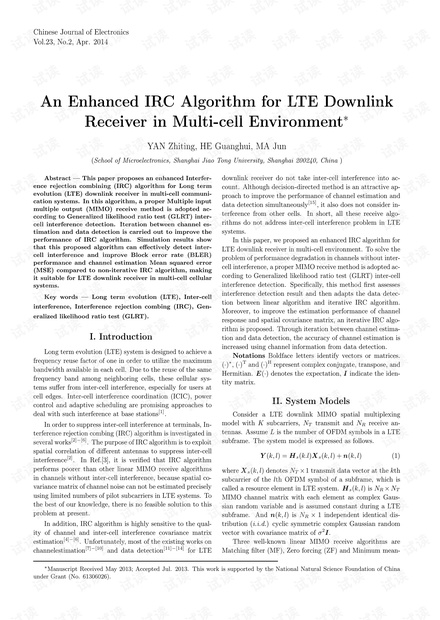本文讨论的是一项针对LTE(长期演进)下行链路接收器在多小区环境下提出的增强型干扰抑制合并(IRC)算法的研究成果。该研究成果主要解决了LTE系统在频率复用因子为一的设计要求下,不同小区之间由于复用相同频段所产生的小区间干扰问题,尤其是对位于小区边缘的用户而言,这种干扰尤其明显。干扰抑制合并技术(IRC)作为一种线性多输入多输出(MIMO)接收算法,在基站侧应对干扰方面显示出一定的前景。 IRC算法的核心目的是利用不同天线之间的空间相关性来抑制小区间的干扰。然而,文献[3]证实,在没有小区间干扰的信道中,IRC算法由于受限的导频子载波数量导致无法精确估计信道噪声的空间协方差矩阵,其性能不如其他线性MIMO接收算法。因此,本文提出的增强型IRC算法通过适当地采用多输入多输出(MIMO)接收方法,并结合广义似然比检验(GLRT)进行小区间干扰检测。在该算法中,通过在信道估计和数据检测之间进行迭代,可以提高IRC算法的性能。 在这项研究中,首先介绍了LTE系统的设计目标,即每个小区能够利用最大可用带宽,而这就要求频率复用因子为一。然而,这种设计也导致了相邻小区之间频段的复用,从而产生了小区间干扰。由于用户在小区边缘尤为明显,因此小区间干扰协调(ICIC)、功率控制和自适应调度被认为是基站端处理此类干扰的潜在方法。然而,本文侧重于在终端侧抑制小区间干扰的方法,并通过IRC算法的调查研究作为基础。 为了有效地解决这些问题,研究者提出了一个增强型IRC算法,该算法的一个关键特征是它在接收端采用了基于广义似然比检验(GLRT)的小区间干扰检测机制。GLRT是一种有效的统计方法,用于检测信号中的已知数据,利用了先验概率知识,在多小区环境中尤其有效,因为它可以区分来自不同小区的干扰源。 在提出的IRC算法中,信道估计和数据检测之间的迭代过程是增强性能的重要部分。这种方法允许算法从接收到的数据中不断学习和更新信道模型,从而实现更好的干扰抑制和信号分离。通过这种迭代,算法能够更精确地估计干扰信号,从而有效降低误块率(BLER)和信道估计的均方误差(MSE)。 文中提到的关键知识点还包括: 1. LTE系统:它是一种为移动通信设计的无线通信技术,用于提供高速语音和数据服务。 2. 小区间干扰:在蜂窝网络中,当相邻小区使用相同或部分相同频段时,就会发生这种类型的干扰,影响通信质量。 3. 广义似然比检验(GLRT):这是一种统计测试方法,用于在统计假设检验中区分不同干扰源。 4. 多输入多输出(MIMO)技术:一种无线通信技术,通过使用多个发射和接收天线来增加数据吞吐量和通信范围。 5. 误块率(BLER):无线通信中用于衡量传输数据包出错的指标。 6. 信道估计均方误差(MSE):一种测量信道估计准确性与真实值之间差异的方法,它衡量了信道估计的精确度。 通过这种改进的IRC算法,可以有效地改善LTE多小区环境中的下行链路接收性能,提高系统的整体性能和用户体验。这项研究成果对于推动LTE技术的发展和提高蜂窝网络通信质量具有重要的理论和实际意义。



- 粉丝: 14
- 资源: 940
 我的内容管理
展开
我的内容管理
展开
 我的资源
快来上传第一个资源
我的资源
快来上传第一个资源
 我的收益 登录查看自己的收益
我的收益 登录查看自己的收益 我的积分
登录查看自己的积分
我的积分
登录查看自己的积分
 我的C币
登录后查看C币余额
我的C币
登录后查看C币余额
 我的收藏
我的收藏  我的下载
我的下载  下载帮助
下载帮助

 前往需求广场,查看用户热搜
前往需求广场,查看用户热搜最新资源
- 金属熔化凝固及多技术下的UDF代码讲解:最强学习资料,深入探索:金属熔凝最强学习资料汇编-涵盖流动传热传质、激光移动热源技术、熔化凝固现象、宏观偏析现象解析及UDF代码精细讲解,fluent金属熔凝
- 船舶电力系统稳定性分析与仿真的Python实现及优化调度(论文复现,含可运行代码及解释)
- 基于Python的渐开线直齿轮动力学与弹流润滑耦合模型仿真及不确定性和敏感性分析
- 基于FPGA的数字电子琴-数电小系统设计【数字电子技术】(使用Vivado中的verilog语言)实验设计代码文件(全)
- 格子玻尔兹曼方法LBM在Matlab中模拟三维多孔介质流动D3Q19的实践研究,格子玻尔兹曼方法LBM在Matlab中模拟三维多孔介质流动D3Q19的实践研究,使用格子玻尔兹曼方法LBM模拟三维多孔介
- 基于COMSOL的三维离散裂隙恒压注浆模型:粘度空间衰减的宾汉姆流体随机圆盘模型研究,基于宾汉姆流体粘度空间衰减的COMSOL三维离散裂隙恒压注浆模型研究,COMSOL 三维离散裂隙注浆模型 基于粘
- 基于双闭环控制与最近电平逼近调制的MMC模块化多电平换流器仿真研究:含技术文档、Matlab-Simulink实现、直流侧11kV交流侧6.6kV电压电流稳态对称仿真分析,基于双闭环控制与最近电平逼近
- chatbox软件压缩包
- 汇川小型机H5U编程特色:伺服驱动器与IO模块配置,梯形图编程直观易懂,卷绕轴速调整与多配方处理,产能统计及数据交互功能强大 ,汇川小型机H5U编程特色:伺服驱动器与IO模块配置,梯形图编程直观易懂
- 磁悬浮轴承MATLAB建模与仿真分析:理论与实践的完美结合,磁悬浮轴承与磁悬浮仿真模型的MATLAB建模与仿真分析,磁悬浮轴承MATLAB模型&磁悬浮仿真模型 ,磁悬浮轴承; MATLAB模型; 磁悬
- 人工智能之深度学习:神经网络分类与回归任务实战资源(源码+数据集+说明)
- numpy-2.2.0-cp312-cp312-win_amd64.whl
- 微信疯传社群测试可用+修复版+免激活去授权版
- 项目实战:Qt图像拼接渐进色图层生成工具v1.0.0(预设四路拼接,多路可通过多图叠层实现)
- numpy-2.2.0-cp312-cp312-win32.whl
- 智能算法在21个工程应用中的全面实践与效能分析:统计指标导出与收敛图可视化 这个标题符合您的要求,既包含了您提供的文字中的主要信息,又简洁明了,易于理解 ,智能算法在21个工程应用中的全面实践与效能


 信息提交成功
信息提交成功